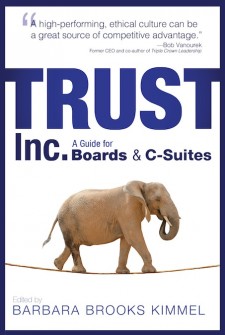Late last year Trust Across America-Trust Around the World published the first in a planned series of award-winning books. TRUST INC., Strategies for Building Your Company’s Most Valuable Asset brings together the wisdom of 32 experts. Six months later we released our second book, Trust Inc. A Guide for Boards & C-Suites. In this book, sixty experts have joined forces to offer 100 strategies.
Throughout the month of August, we will be featuring 31 essays from our second book. Each stands alone as an excellent resource in guiding Boards and C-Suites on driving a trust agenda at the highest level in the organization, and provides tools for those who choose to implement trust-building programs in their organization.
This eleventh essay in our series brings advice from Finland. Taina Savolainen is a Professor of Management and Leadership at the University of Eastern Finland, Business School and leader of the research group of Trust within Organizations. She is a trust trainer and educator focusing on inter-personal trust building skills.
Trust in the Boardroom
Competitive advantages strongly rest on creating and sharing knowledge in the boardroom where trust plays a significant role as an influential intangible asset for executives. Trust is a powerful resource for creating and facilitating cooperation between board members, CEO, etc. Managing trust successfully is a vital skill for senior executives. According to the recent report “The Trust Deficit”, on the views from the board room, interviewed business leaders were explicit that, not only was trust an important issue for business in general, but that it was particularly important for senior executives. Making trust-based judgments was thought to be an important skill for all in business. Business leaders felt the importance of this ability increased at higher levels within a business. Making trust-based decisions was seen as an especially important skill for business leaders, but also as an important responsibility discharged by board members (p. 24). Trustworthiness in business was expressed by one Chairman as follows “Trustworthy means, if you say you’re going to do something, you do it, and you don’t ever claim to be capable of doing something you’re not capable of, and if something goes wrong, you fix it…” (p. 14) ( Chairman, FTSE 250, The Trust Deficit: Views from the Boardroom.)
I hope you have enjoyed this next sneak peak into our second book. If this brief look behind the door has been helpful, follow this link to order both of our books online.
August 1: There’s a Reason Why We Call Them Trustees explains why being an “absentee landlord” doesn’t work.
August 2: Kill the Evening Before Dinner and take a small group of front line employees to dinner instead.
August 3: In Head of Business- Hope for the World we introduce the Winston “V” Model.
August 4: Reputation vs. Trust and why leaders should care more about the latter.
August 5: C-Suite Must Speak With a V.O.I.C.E. of Trust, a new communications model.
August 6: It Ain’t What You Do (It’s the Way You Do It) discusses an organization’s core values and traits.
August 7: Superficial CEOs and Their Boards talks about the fiduciary responsibility of board members.
August 8: Headline: Be the Leaders Others Will Follow we learn about consistency between actions and words.
August 9: Towards a Mindset for Corporate Responsibility requiring a shift in mindset on the part of boards.
August 10: Warning: Don’t Drown in the Slogan Swamp explores the (mis)use of slogans in corporate America.
Barbara Brooks Kimmel is the Executive Director of Trust Across America-Trust Around the World whose mission is to help organizations build trust. She is also the editor of the award winning TRUST INC. book series. In 2012 Barbara was named “One of 25 Women Changing the World” by Good Business International.
Should you wish to communicate directly with Barbara, drop her a note at Barbara@trustacrossamerica.com
Copyright © 2014, Next Decade, Inc.




Recent Comments